I hesitated to write this review, not because I feared that you, dear reader, might not agree with me on the merits, but because I feared that thoughtful criticism of the kind I’m interested in engaging in doesn’t matter anymore, at least not in the context of cultural spectacles like Star Wars, where “if it feels good, then it is good” suffices for the casual movie-goer. Yet to be honest, even this rejection of the literary analysis of pop culture doesn’t bother me so much—what bothers me, lately and especially in the context of The Rise of Skywalker (TROS)—is the presumption that critics of the movie are on some secret mission to undermine the film at any cost, for reasons cynically political or cynically fanboyist, because nothing will ever be “good enough” to satisfy the fans.
Some fans certainly are on that mission, as they were with The Last Jedi (TLJ). Some fans are mad because they have unrealistically romanticized a Star War that never was. As for me, I don’t even really consider myself a “fan” of Star Wars so much as a purveyor of the science fiction genre in general, and Star Wars is quintessential space opera in that regard. The saga has never been all that attractive to me from a thematic point of view anyway, because unlike say Star Trek, which argues that the future is humanitarian and egalitarian and largely third-stage communist, Star Wars doesn’t really argue much about the future except that destiny is inescapable and greatness perhaps genetic. But none of that matters. What we’ve always loved about Star Wars is the fact that it has its feet firmly planted in its space opera roots: pulpy action-adventure plots, clear cut heroes and heroines, and human melodrama that tracks to Western monomyths in ways we can predict and enjoy.
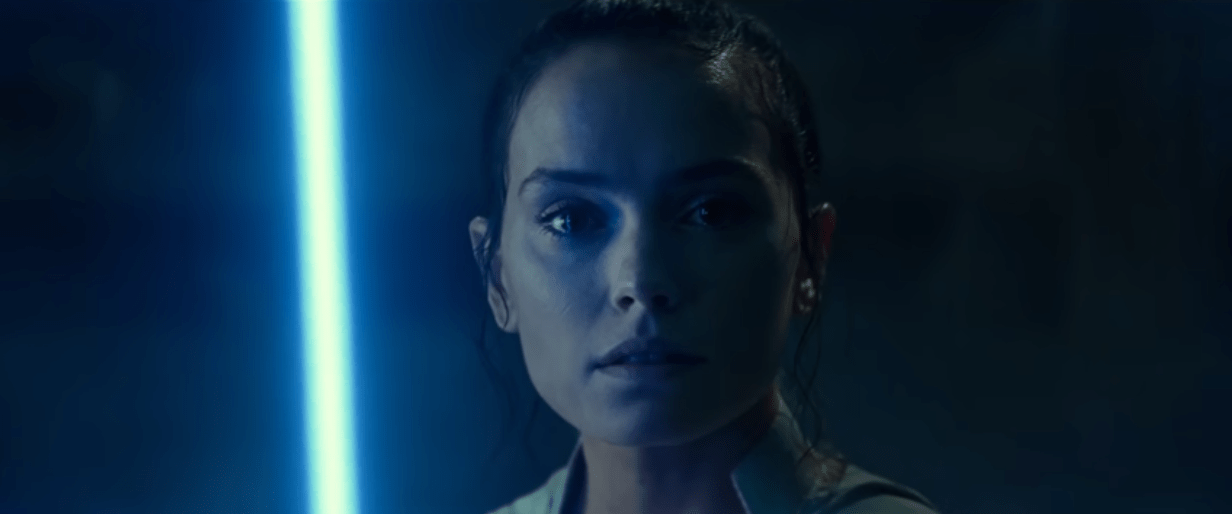
All of which is to say that it shouldn’t be that hard to extend the magic of the Original Trilogy if you hew closely to these concepts. The Mandalorian is proof that a return to form in the Western monomyth can do exactly that (perhaps such a review is “a good story, for another time”?) If we set aside the fact the new trilogy is essentially the consequence of pantsing the writing of a multi-billion dollar franchise—that is, try to judge it on the basis of its actual contents rather than its outside influences—the inevitable conclusion we come to is that the new trilogy has failed us not because of its ideas, but because of its execution of those ideas. And that’s something we can talk about, divorced from whatever biases we might have about fandom or politics, because that sort of failure is a failure of the craft of storytelling.
Big picture for a second: It’s December 17, 2015. Our excitement for Star Wars has been frozen in carbonite for a decade thanks to the Prequel trilogy, so all JJ Abrams has to do is simulate the feeling of watching a Star Wars movie and we’ll pretty much pee ourselves. That’s what JJ is good at doing: simulating authenticity. He is great at setting up a cinematic moment and capitalizing on it, even if the narrative substance of that moment weighs the equivalent of a wet paper towel. The Force Awakens (TFA), despite being a hollow simulacrum of A New Hope, gave us the momentum we needed to re-engage with the Star Wars universe on terms that respected the genre-cadence of the Original Trilogy. JJ played it safe, and, at the time, we hoped his setting the stage with the familiar could serve as a springboard for launching into the unfamiliar.
Which leads us to The Last Jedi, the eighth film in the franchise with actual new ideas that are unfortunately executed in ways that either go too far and screech against that very genre-cadence JJ restored in the seventh film, or don’t go far enough, and strike me as peevish rather than subversive. Many of my friends who appreciate the film point to three key “subversions” as being the linchpins of its genius: Luke’s disillusionment with the Jedi Order, the reveal of Rey’s lineage, and the death of presumed “big bad” Snoke. Let’s discuss each of these in turn.
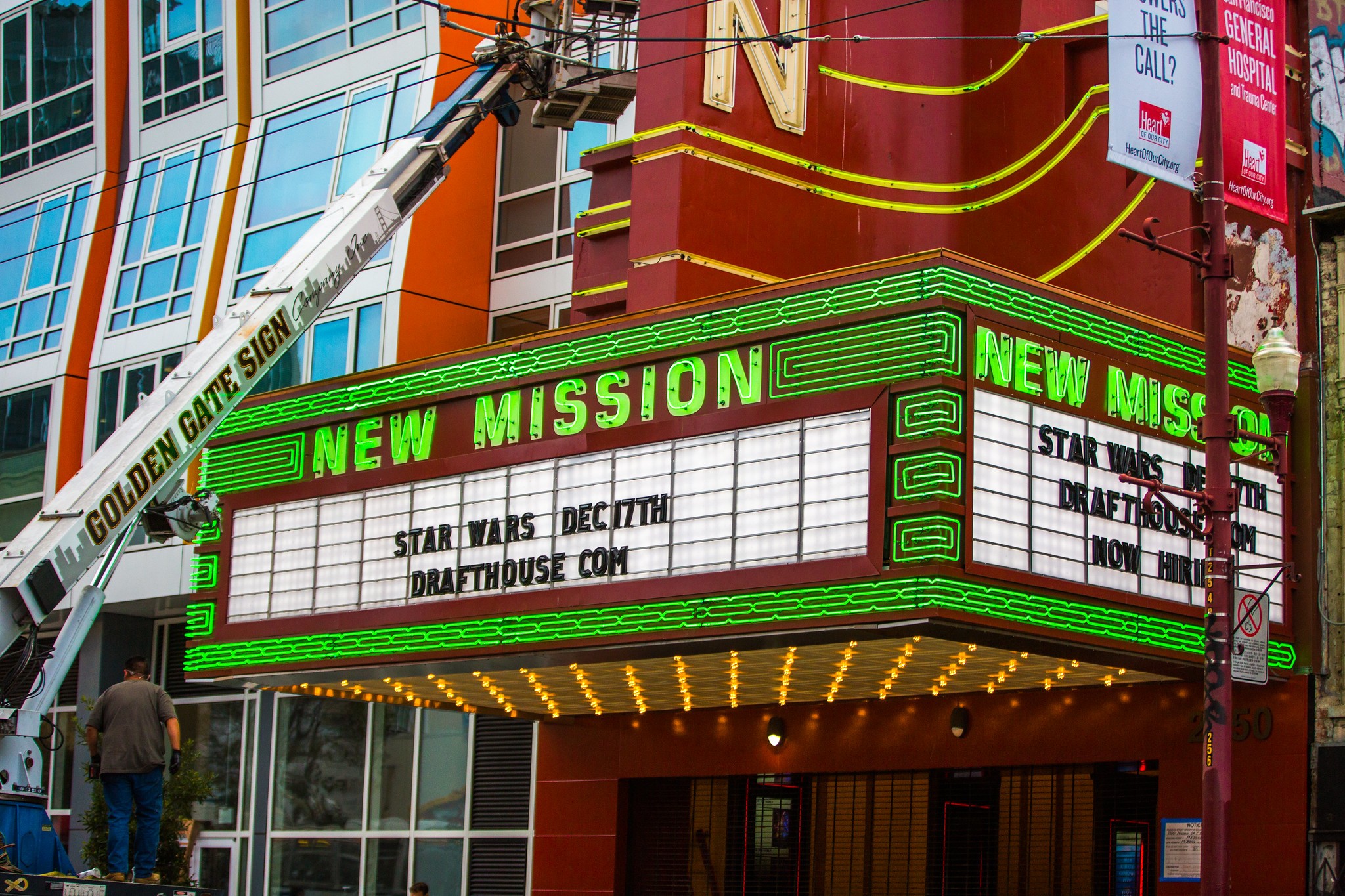
The disillusionment of Luke with the Jedi Order—first of all—is hardly an innovative idea (see Dark Empire), but it’s certainly welcome and refreshing for the character of Luke after The Force Awakens’ naive optimism for destiny. I was completely on board with the whole concept, until the moment Luke is depicted with murderous intent, hovering over his young nephew with his lightsaber ready to strike. It’s one thing for a character like Luke, who endured electrocution at the hands of the Emperor in order to redeem his mass-murdering father, to contemplate whether his dark-side seduced nephew was unfit to continue his training, but it’s another thing entirely to suggest the character might contemplate murdering a child. This isn’t about fans being precious about Luke’s character: Luke-as-child-murderer is unprecedented, incongruent with what we know about him to the point of being unbelievable, and takes an interesting turn for the character too far in a direction that makes no narrative sense.
On the other hand, the reveal of Rey’s parentage as being “nobodies” is my favorite choice Rian Johnson makes in TLJ. The idea that the Force belongs to nobody and everybody is probably the most heroic idea in all of Star Wars history, and it jives with what we know about the hero of the Western monomyth, who prides himself on being a pull-yourself-up-by-your-bootstraps crusader against the universe’s indifference toward individual autonomy. One of the reasons why we hated the Prequels is exactly because those films double down on the bizarre genetic determination suggested by the Skywalker lineage. And it’s too bad The Rise of Skywalker rejects Rian’s single most important contribution to the saga.
As for all the misogyny directed at Rey’s character: I never really understood fans’ objections to her allegedly “quick” competence with the Force. Honestly, do we need extended training montages for Rey when we all know how Jedi work and just want to get on with them wielding lightsabers and doing cool stuff? I don’t think we do, and TROS didn’t need those montages either. I like that Rey becomes powerful in the course of the first film, unlike Luke who is mostly lame and boring for the majority of A New Hope. What’s wrong with Rey isn’t her supposed “Mary Sue-ness,” but actually her Lukeness, her similarity to what came before, which is a consequence of commercial expediency if anything. I mean, this is Star Wars, for chrissakes! There are elephants playing trombones in bars. Rapey gangster slug monsters on flying sand boats and violent teddy bears from the moon. Why not cast Rey as some bisexual Chinese Twi’lek with anger management issues? Why do Rey and Jyn Erso (from Rogue One) and Kira (from Solo) all look like the same tedious interchangeable brunette barbie doll? Star Wars under Disney’s yoke is too milquetoast to do anything truly subversive with its casting, let alone its ideas. They would never cast Rey as something with a tentacle or scales or a penchant for nihilism or a superiority complex. Instead of letting Poe and Finn fuck, we have lesbians-as-window-dressing in TROS, as if 2019 were Star Trek circa 1968 practicing Kirk and Uhura’s first interracial kiss.
Yes, I know this is a review of TROS. I’m getting there.
Onward to the death of Snoke. Narratively, it’s also an unexpected move: get rid of the big bad we’re all comfortable with (and quite frankly bored of): he is a carbon copy of the Emperor that JJ set up because JJ is incapable of generating new ideas. The only problem here is that doing so leaves behind a Chekhov’s gun: Snoke is a mysterious character with distinctive scars begging to be explained, with conspicuous dress unlike that of previous Dark Lords, whose origin defies our understanding of what sort of evils (Sith or otherwise) came before in the narrative. If Snoke dies with no explanation at all, then we are left with questions such as, Where was Snoke during the rest of the trilogy? How does his presence factor in with the 1:1 Sith-to-apprentice ratio? Where did he gather all these resources to build his Starkiller Base? Who trained him in his dark side powers, and so on and so forth. These are not the nitpicks of fanboys but honest questions that spin out of plot. His mere existence raises questions you can’t just dismiss without damaging the integrity of the rest of the narrative. It’s fine to kill him off, in fact I actually appreciate the intent behind killing him, but you have to fire the gun you leave behind or else you do your viewers a disservice. Even a simple explanation such as, “he was merely a merchant who discovered a Sith artifact and got corrupted” would suffice. But the true explanation—which we know after TROS is the result of commercial expediency (again) rather than some grander narrative—is that he’s merely a puppet of the Emperor, which would be satisfying in and of itself if we believed even an iota of foresight went into the idea prior to the final film being conceived of.
“But Obama did the same thing!” you reply with whataboutism, referring to the Emperor of the Original Trilogy, who had no origin or explanation for his rise to power either. But even if we grant this objection (which I do not) one bad narrative choice in one film does not justify another bad narrative choice in another film. Needless to say, the Emperor as a concept was originated by the Original Trilogy, created in a vacuum lacking the expectations necessitated by previous worldbuilding. This is not the case with TROS, so the objection is nonsensical.
Honestly, if TLJ really wanted to subvert expectations, Rian Johnson should have let Rey and Kylo team up at the end of the film. In such a scenario, Star Wars would have truly “let the past die,” breaking the cycle of Jedi v. Sith and thrusting the new trilogy into terrain no one could anticipate, with no clear big bad except the possibility of rendering something new with the saga.
Which brings us solidly into TROS territory, with the return of the Emperor, a plot conceived of originally in the Expanded Universe’s Dark Empire. Meant to encapsulate a nine-movie arc, the plot isn’t a bad one, and I don’t have any objection to it as a concept.

As a concept. But TROS is like one of those greasy Egg McMuffins in a McDonalds commercial that looks tasty at first glance, but is actually put together with Elmer’s glue and beeswax. Again, the reason why TROS is a disaster is not because of its ideas, but because of its execution of those ideas. There are serious narrative problems with its plot, characterization, and pacing that you may choose to ignore because you enjoyed the cinematic rollercoaster ride so much, but they do exist, and if you extract enjoyment from a film because it appeals to your critical sensibilities instead of your masturbatory need for lizard-brain self-gratification, then these deficiencies may interfere with your enjoyment of it. For such consumers of films, there is a difference between masturbation by media and mastication of it. The film Masters of the Universe, for example, is one of my favorite movies of all time. It stars Monica from the TV show Friends, Frank Langella, and some other nobodies, and it’s about an inter-dimensional skeleton doing battle against a barely literate barbarian during the 1980s. I watch it every year, gleefully. However, I also acknowledge that it is a flaming plastic turd, originally engineered by an evil toy company to sell He-Man figurines. It is not at all a good movie, and even though I enjoy eating that shit sandwich once a year, I don’t pretend that’s foie gras stuck between my teeth afterwards.
So shall we talk about the narrative deficiencies in TROS dispassionately, now that we’ve dispelled all the reasons why you might be skeptical of my intentions?
Obviously we start with the opening crawl, which tells us that the Emperor has returned and broadcast a message to the galaxy to that effect. My first impressions of this approach to storytelling are multiple: why is the Emperor revealing this secret about his return before he’s unleashed his legion of Death Star Star Destroyers? Isn’t this something we should see rather than be told (alas, such showing is reserved for Fornite players)? How does this reveal square with the last-known state of affairs in TLJ? What is going on in the universe since we last saw it? Of course, none of these questions have any hope of being answered because the reason why TROS opens in this way is because JJ has no time to comfortably connect the dots between films—instead, he’s “done” the narrative work through TV promos prior to our viewing, so we already know what’s coming, we’ve been primed for JJ’s shortcut at the expense of the film’s stakes, because, as we’ll learn, TROS relies on external supports in order to do the majority of its storytelling.
Crutches like these arise also in the dialogue. In TROS, the cinematography is frenetic, breathless, and largely expository. For example, besides telegraphing what they’re doing, Finn and Poe’s conversations are almost entirely made up of one liners and banter (except perhaps where Finn’s dialogue is devoted to his pining after Rey—for reasons JJ claims have to do with his being force sensitive, a JK Rowling-esque, post-storytelling retcon that is not only unnecessary but not supported by the text). But of all the blundering dialogue in this film, my favorite has to be the dialogue in the stitched together scenes with Princess Leia, whose posthumous conversation with nobody has been sadly resurrected in a training sequence with Rey. The writing is terrible because JJ is forced to write around whatever shreds of utterance remain from earlier shoots with Carrie Fisher. This is commercial expediency, all over again. Some people hold the director blameless, given the circumstances, but I do not. Even Palpatine, whose dialogue in the Prequels (the Prequels, for godsakes!) includes some of the most iconic one liners in all of SWs history, is reduced to repeating himself, because JJ cannot write anything new.
Macguffins, however, are the single worst offenders in TROS. I do not frankly understand why it is so difficult to write a plot that does not feature so many Macguffins–doesn’t it take more work to include more of them? What is the plot of TROS anyway? Rey needs to find a thing that will help her find a place, but she needs another thing to use the thing that will take her to the place, however that thing needs a thing to be used, which after she finds the thing and is able to use it to find the other thing, it’s destroyed, forcing her to go to a place where she throws the thing away, only for Luke to remind her she needs to use the thing to go to the place. (Best elaborated on in Red Letter Media’s review of the film, below)
Critics have complained that this movie is a series of “fetch quests,” and while they are correct, what’s worse is that these fetch quests require increasingly greater suspensions of disbelief. First, the untranslatable Sith encoding which has no prior justification in the film universe, and second, the ancient Sith knife that anachronistically orients its user to the second Macguffin. Do we really need two Sith holocrons, an encoded Sith text, and an ancient Sith knife to get Rey from point A to point B? Can’t this be accomplished with tighter plotting so we’re only dealing with a single Macguffin? Or, you know, maybe interaction among, god forbid, characters?
Unintentional multiplicity of anything in a narrative reduces the overall impact of any of the things involved. Take the many resurrections in TROS, for example. There are five of them, which is five too many. Any resurrection at all is enough to endanger your story’s stakes. First, obviously, we have the resurrection of Palpatine himself. This resurrection is the premise of the film, so it’s one we have to take for granted, that Palpatine somehow survived the explosion of the Death Star and has been alive and well for 30 years. Again, it’s absurd, but not so unacceptable a premise given that we’re talking about a guy whose favorite past-time is shouting “UNLIMITED POWAR” whilst electrocuting himself by his own Force lightning. But nevertheless, Palpatine’s return is a resurrection, and it adds weight to our already-thin suspension of disbelief.
Then, we “kill off” Chewbacca in a stunt that lasts all of three minutes, and later C3P0 as well, after heartfelt goodbyes that ultimately amount to nothing when his memory is restored as easily as it is erased. At this point, as viewers, we’ve been desensitized to character death, which deflates the stakes of the narrative to such a degree that we fear no danger for our characters, protected as they are by Disney’s soft embrace. So instead of pulling back to restore stakes with what little narrative integrity is left of the film, JJ not only resurrects pointless bounty hunter Zorii Bliss and Jar Jar surrogate Babu Frik, but kills and resurrects its principal characters several more times: first Kylo when Rey stabs him, then when Kylo is thrust into the pit, then Rey when she is electrocuted to death by Palpatine, then Rey again when she is resurrected by Kylo, then Kylo again when he dies by resurrecting her! By the time Kylo dies for the last time, his slump to the earth is more comical than tragical, if you’ve been paying any attention at all to what’s happening.
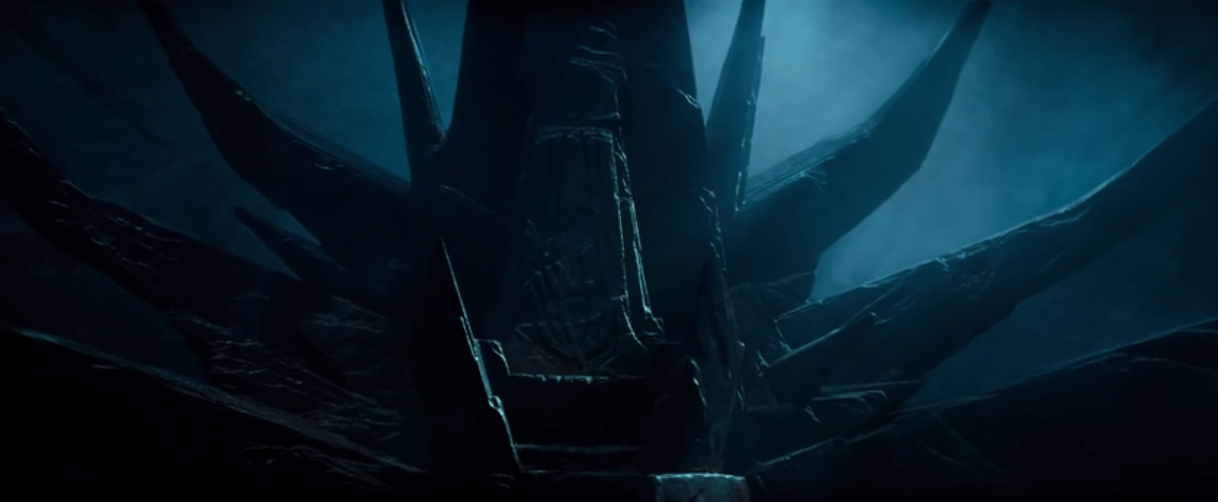
We already know the new trilogy has issues with manufacturing threats that are even remotely interesting, let alone dangerous. Even the Original Trilogy was so enamored with the Death Star that it reprises the technological terror in The Return of the Jedi. So, stolen straight from the EU playbook, TFA introduces a Sun Crusher in the form of the Starkiller Base, which is obviously just a bigger Death Star. But can we blame JJ for his total lack of originality in introducing a fleet of Star Destroyer Death Stars (i.e., World Devastators from the EU) as the final superweapons of the new trilogy? Yes. Yes we can.
First of all, let’s ignore the fact that the construction of such a fleet, unless it were conjured into existence by Sith magic, would require extraordinary economic resources that somehow the Emperor was marshaling in secret for 30 years on his navigationally inaccessible planet with an army of “Sith loyalists” who apparently have no need to interact with the rest of the galaxy. The real question is, what is the point of the Death Star to begin with? Isn’t it a deterrent against resistance to the galactic hegemony? The Death Star is supposed to be a symbol of that hegemony, the crown jewel of the Empire’s domination over that democracy Palpatine “loved” so much. If your deterrent is the total destruction of every planet in the galaxy, what is even the point of anything? I guess these are silly questions, though: this is the Emperor we’re talking about, a man whose response to law and order is that he IS the senate!
I suppose my larger point here is that so many questions shouldn’t arise so profligately from the mere introduction of a concept into a narrative. The Snoke tanks, for example, as clumsy as they are a non-explanation for Palpatine’s survival, do more work to explain and expand upon the narrative than 10,000 Death Stars because we know that cloning is a thing in the Star Wars cinematic universe, and we can connect the dots ourselves, unlike a fleet of Star Destroyer Death Stars on Exogol, which raises far more questions than it answers. Our suspension of disbelief is spread so thin, so completely, and yet even at this point the movie does not relent. Because obviously to defeat such a ridiculous threat, all it takes is a handful of people on horses (actual horses), and the invocation of Lando Calrissian, who mysteriously marshals 10 million Rebellion forces out of nowhere, instantly to serve the dramatic needs of the plot.
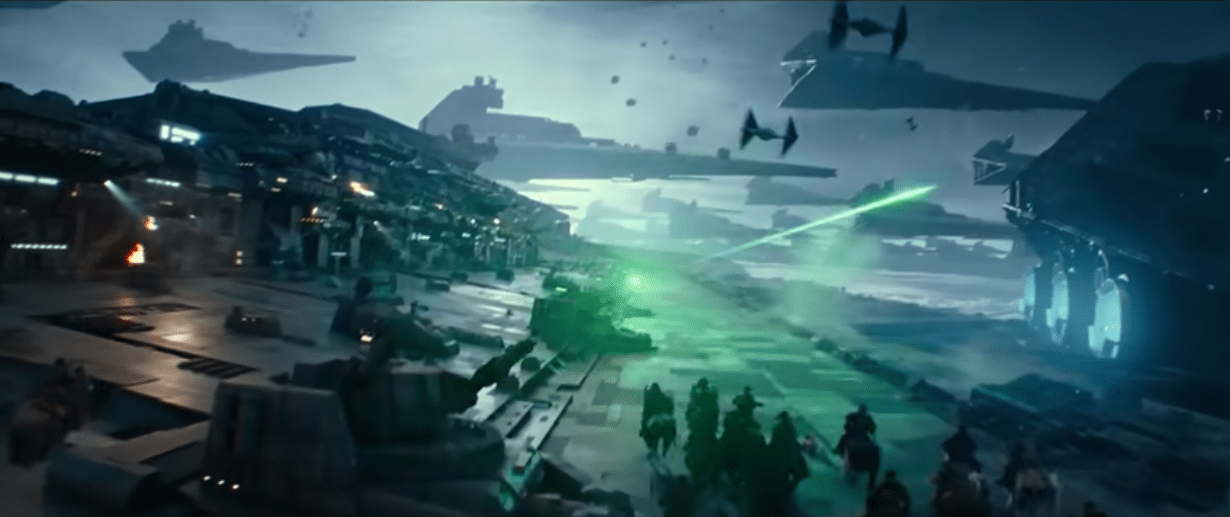
Make no mistake: The Death Star’s exhaust port is the same sort of “ask” as Palpatine’s eight million Death Stars in TROS. But at least that exhaust port served some other narrative purpose besides being a convenient weakness for an otherwise unassailable fortress: in A New Hope, it represents the implementation of Luke’s faith, it calls back to his very first talent shooting womp rats when he was a useless farm boy on Tatooine, it suggests that if we only believe in ourselves (via the Force), we can overcome any obstacle to the destiny of our greatness, even that of planet-destroying superweapons. But TROS simply makes too many asks like these, with no narrative payoff, until the plot becomes a series of conveniences that add up to set pieces intended solely to make you feel one way or another at the disservice of the story itself.
This, my dear friends, is what I am lamenting when I say I cannot enjoy this new trilogy: TROS amounts to a flash of emotion at the tail end of a pantomime; it is not a story, it is the end result of a three-part spectacle, designed by men who never intended to tell a story. TFA wanted to evoke an emotion; TLJ wanted to subvert it; and TROS spent 50% of its time undoing its predecessors’ subversions and 50% of its time rushing to tell us a story it didn’t have the space left to tell.
As the franchise plods on into cinematic infinity, we can only hope that people like Jon Favreau are given the time, space, and freedom to turn great ideas into stories rather than spectacles.
Help me Mandalorian (& Baby Yoda)! You’re my only hope…


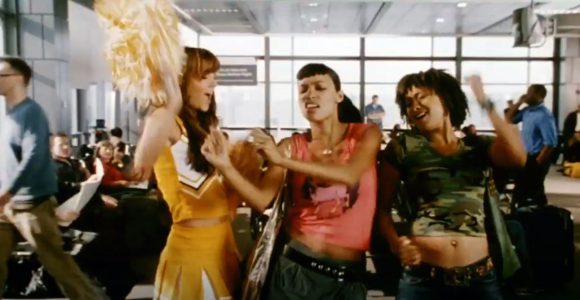

Comments on How to Eat a Shit Sandwich: Rise of Skywalker, in Review
justrando
How poorly must one misunderstand star wars to not even read the opening crawl of the first film
Daniel Quinn
Care to elaborate?